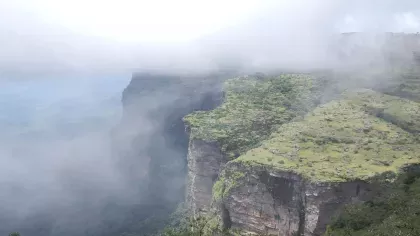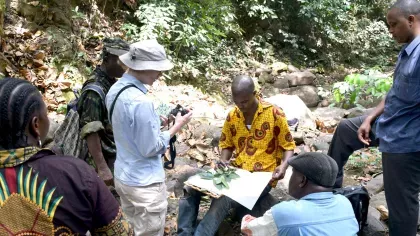14 February 2018
Guinea: The Campaign for a National Flower
The Republic of Guinea is on a mission; to boost awareness of their incredible biodiversity through a new National Flower Campaign. Kew scientist Charlotte Couch, working on the Tropical Important Plant Area’s of the Republic of Guinea project, gives us an insight into the work so far.

National Flower Campaign
In April 2016 we were awarded Darwin Initiative funding from the UK government, which has allowed us to take a different approach to our work in Guinea. In the past, our team would travel to Guinea for a few weeks, frantically trying to complete a range of activities before returning to the UK. In September 2017, we adopted a different approach and I travelled there for three months to work on the project and to support the National Herbarium of Guinea, who are our main partners.
This trip had several aims. Primarily we wanted to launch the Regional and National Flower Campaign and start to raise awareness of the unique flora of Guinea.
Unlike a lot of countries, Guinea does not have a national flower yet, and our partner Plantlife International, has run a similar campaign in other countries with great success. Guinea is one of the most biologically diverse countries in West Africa, which can generally be separated into four natural regions with very different characteristics. So, we first decided to run a regional campaign to find four regional winners followed by a final to confirm the national flower of Guinea.
Our target audience
We wanted to highlight our campaign specifically to secondary school children as well as local community groups. We think it’s important to start a conversation about the unique plant diversity of Guinea and the environmental threats it faces to the people of Guinea, so they can support this conservation work in the future. We did this by inviting representatives from the state schools and communities to regional workshops to discuss the campaign. Alongside this, we ran a social media campaign on Facebook, Twitter and the website of the National Herbarium.
Over the past 10 years the mobile network has grown exponentially across Guinea and many people have access to the internet through computers or smartphones, so it made sense to communicate using the latest technology. The website has been up and running for a couple of years, but this was a new venture into the territory of social media for the National Herbarium of Guinea and me.
The workshops generated a lot of enthusiasm and discussion about the environment and the flora of Guinea, especially among the educators, who want to include more content about Guinea’s unique biodiversity in the curriculum. We are currently planning a teacher’s booklet on the flora and habitats of Guinea which will provide a much-needed teaching resource.


First results of the National Flower Campaign
The results of the campaign have been collated and we have just announced the winners for the four regions:
Guinée Maritime: Diospyros feliciana; Moyenne Guinée: Vernonia djalonensis; Haute Guinée: Dissotis linearis (not pictured) Guinée Forestière: Habenaria jaegeri



Gathering data on rare species
Alongside the national flower campaign, we have been continuing our field expeditions, filling the gaps in our knowledge on threatened plant species of Guinea. Our work is based at the National Herbarium of Guinea in Conakry, where all specimens are returned and stored. Out in the field we have two fieldwork leaders; one leading expeditions in Coastal and Middle Guinea and another in the Forest Guinea region. I work with both these fieldwork leaders, as well as with the National Herbarium, ensuring that specimens are collected and recorded appropriately.
The data gathered is used for assessing the threat status of the species. In December 2017, we published a preliminary checklist of threatened plant species for Guinea in the journal PeerJ preprints. This is another of the goals for the project and we aim to produce a definitive list by the end of the project to help with environmental planning in Guinea
Much can be achieved in a three-month extended trip, so I will be heading back out to Guinea in March for another three months!




